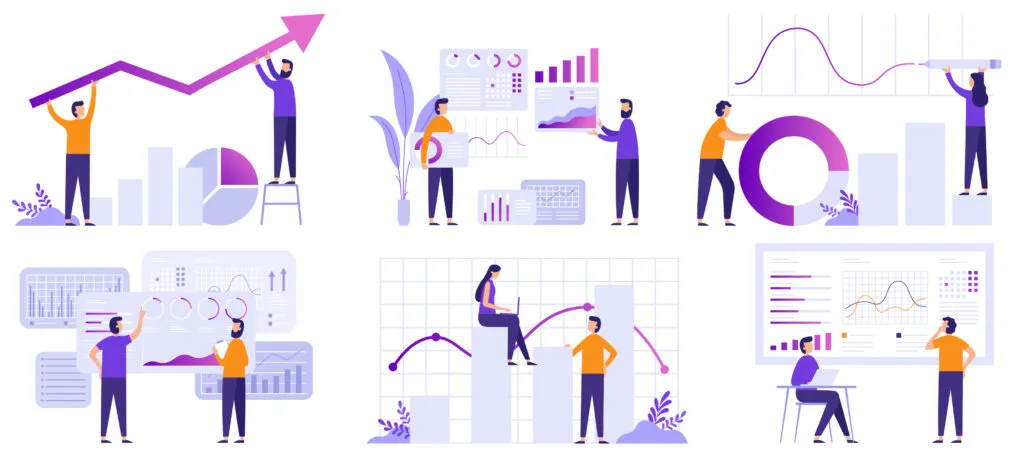Migrating to Google’s GA4 - 7 Headaches and How to Avoid Them

Ready or not, Google is updating Google Analytics from Universal Analytics (also known as UA or GA3) to a completely new and upgraded platform, Google Analytics 4 (GA4).
While that may not be welcome news to countless GA3 users (28.1 million websites currently use Google Analytics), the clock is ticking, and Google is urging users to migrate to GA4 immediately.
There is a good reason for the urgency. Starting July 1, 2023, Google UA will stop collecting new data from user interactions, and it will not be possible to migrate existing data after that date.
This looming deadline makes it vital for users to set up GA4 on all their websites and apps now so they have as much data available as possible when UA is sunsetted. After the July deadline date, UA will still be accessible to view, but it will stop collecting new data.
What is Google Analytics 4?
Despite offering much of the same functionality as Universal Analytics, GA4 is a completely new product with an entirely different interface, available metrics and data collection methodology.
GA4 is Google’s response to shifts in consumer behavior and significant changes to online privacy policies. With GA4, Google appears to be preparing for an increasingly privacy-conscious world where cookies aren’t as available for tracking.
Google says GA4 will bring an evolution in measurement standards, allowing users to measure different kinds of data from iOS and Android apps and the Web. GA4 allows privacy-first tracking, AI-driven predictive analytics and cross-channel data.
Why Companies Fear Migrating to GA4
The prospect of switching to an entirely new analytics platform has not been welcome news for businesses that handle large amounts of business-related data. Full-scale migration is always risky.
Ecommerce companies that depend on the accuracy of customer data to make business decisions could be particularly impacted by the potential loss of valuable data during the migration process.
Also, a lengthy migration process and a big learning curve could spell workflow disruptions, especially for companies migrating large amounts of data. Then there is the problem of data security. Will some data be lost in translation, and if so, how much?
For these reasons, a hesitation to upgrade to GA4 is understandable. By all accounts, migrating to GA4 is not a walk in the park and comes loaded with challenges. So let us take a look at GA4, how it differs from GA3, the headaches that come with migrating to a new analytics platform, and how to overcome them.
What’s the Difference Between GA4 and Universal Analytics/GA3?
The key difference between Google’s analytics platforms is that GA4 is an entirely new architecture. Whereas Google built the GA3 model around the concept of sessions and page views, GA4 focuses on events instead. GA4 classifies every action as an event — anything from page views, clicks, form submissions or custom events.
According to Google, this architecture change allows GA4 to collect much more data than UA with a shorter measuring process. And of interest to ecommerce brands, GA4 gathers deeper insights into user activity on websites or apps. In fact, Google says GA4 can track just about anything, not just web traffic.
The 7 Challenges of Migrating to GA4
 Switching over to GA4 comes with many headaches, including data security concerns, compatibility issues, downtime during the migration, and the overall complexity of the process. These issues can be especially concerning for digital ecommerce marketers who need constant access to up-to-date data. Here are five headaches reported by users who have already migrated to GA4.
Switching over to GA4 comes with many headaches, including data security concerns, compatibility issues, downtime during the migration, and the overall complexity of the process. These issues can be especially concerning for digital ecommerce marketers who need constant access to up-to-date data. Here are five headaches reported by users who have already migrated to GA4.
1. Running Out of Time
Universal GA will stop tracking data by July 2023. According to Google, standard Universal Analytics properties will stop processing new hits on July 1, 2023. Their 360 Universal Analytics will stop processing new hits on October 1, 2023.
2. Lack of Migration Support From UA
According to users who have already migrated, GA4’s biggest drawback is an inability to migrate existing data from UA.
This limitation only affects existing UA users, but data for those users is broken into two separate analytics systems.
This split makes it impossible to identify patterns across both data sets without first exporting them into a separate system for analysis.
To avoid this problem, users must set up GA4 on all their websites and apps now so that as much data as possible is available when UA sunsets.
3. Complex, and Costly Data Integration
Companies that handle large amounts of data must also deal with the complex and time-consuming task of integrating their existing data with the new GA4 platform, which requires migrating all data from their old platform to the new one.
This could take considerable time for companies with huge data banks, as migration involves a lot of tagging, retagging and refining data layers.
This isn’t a migration as Google is advertising – it’s an entirely new architecture that will involve a manual, complex installation requiring admins to both applications until GA3 is discontinued.
Making the transition means you first must set up GA4, then set up Google Tag Manager, then tag (or retag) every event on your site…and then wait for new data to be collected…and then cross your fingers and hope you’ve tagged the suitable events. Such an extensive process also concerns data security and potential data loss during migration.
4. No Retroactive Data Collection
One of GA4’s biggest drawbacks is that it is a new property designed to collect both website and app data to better understand the customer journey.
While that sounds well and good, a new property also means users must start from scratch. None of a user’s historical data will transfer over from UA to the new platform.
The data stream is only available when they start tracking an event inside GA4. Brands still can’t see what’s happened in events they haven’t yet chosen to look at.
Despite the promise of “Codeless Tracking,” GA4 still requires using Google Tag-Manager and manual tracking, which means teams cannot self-serve.
You’ll still have an incomplete and biased dataset with no retroactive data capability, and teams will have no way to surface unknown areas of friction.
5. Historical Data Will Not Transfer to GA4
The new GA4 platform will collect new user and session data once brands set up the platform. For this reason, users should migrate to GA4 as soon as possible.
This is one of the most challenging Google Analytics 4 problems, especially for businesses handling large amounts of data.
Some users exported all their GA data to their data lake; only BigQuery comes as a default integration. BigQuery integration is included at no charge.
But you will have to pay for any data use above the free model’s limitations, which are 10 GB of storage and 1 TB of query data processing per month.
So be sure to factor data costs into your switchover calculations.
6. Data Inconsistency
GA4 tracks data in a very different way than Universal Analytics. Even metrics with the same name like sessions and users will be measured differently.
Admins and teams must live in both applications in tandem better to understand the delta in metrics between the two platforms until GA3 is discontinued.
They must set up dual tracking, choosing essential events, then organizing and re-tagging everything on your site.
Some businesses estimate this could take years. Migration of UA properties to GA4 can be problematic, regardless of whether you do this on your own or let Google’s tool automate the process.
The process becomes even more complex if you have a lot of data or many custom configurations.
7. Steep Learning Curve
GA4 is an entirely new version of Google Analytics, with a redesigned user interface and features, so the learning curve is considerable.
Grasping and understanding the new features of this platform will be time-consuming, particularly for businesses that deal with large amounts of data. GA4 is also highly customizable, which makes it even harder to learn.
It could also be costly since many companies might need to hire third-party experts to help set up and implement the new platform.
How To Overcome Challenges when You Migrate to GA4
Getting over the hurdles inherent in migrating to GA4 is simple: learn as much about GA4 before and after the migration. Companies that immerse themselves in GA4 education will get through the learning curve faster and avoid workflow disruptions.
But time is not a resource you can always count on, that’s why your business may want to consider a more intuitive supplemental tool like Air360 that collects and displays the data you need. Here are some benefits to diversifying your analytics tools.
1. Gain time and don’t lose any data
Don’t have a tagging plan yet? No worries. Install the Air360 pixel, and track every interaction and session by default.
This means you instantly have access to historical data, all the way back to when you installed your analytics tool. If you realize that you wish to track a specific behavior, it’s already there giving you peace of mind.
2. Simplify your tagging migration
Not clear on what to migrate to GA4? If you have Air360 installed on your website will clarify what events you need to track on GA4.
Leave all interactions for Air360 (auto-tracked, no tagging) and just direct conversions to GA4. This reduces the time and resources required to get the data you need.
3. Never tag user interactions again
The tagging and mapping era is over. With Air360 auto-tracking, a codeless tracking type that automatically captures user behavior like clicks and page views before you choose to track them, there is no need to tag any user interaction. simply save events. It is much more intuitive and less resource-intensive than any other solution.
4. Find things you did not know were happening
Get what, how and why your users are behaving a particular way. Go beyond web analytics and easily identify areas of frustration and get the recommendations you need to increase your conversion.
Simplify Your GA4 Migration with Air360
Fortunately, Google recognizes the challenges. To that end, the company is providing businesses with resources to help them learn how to use GA4, including online courses, certifications, training guides and support forums.
Google is also working with partners to provide businesses with expert advice and support with the migration process.
Ultimately, to migrate to GA4 successfully and collect the data you need, you may want to engage a partner.
Air360 is a dynamic user-experience analytics solution that gives DTC ecommerce brands the peace of mind to safely back up data and streamline retagging and migrating processes.
Air360 will help transform data into actionable insights into how visitors use your website and apps.
This deeper understanding gives DTC ecommerce brands a better understanding of customer behavior, resulting in greatly improved conversion rates and increased revenue.
Contact Air360 today!
